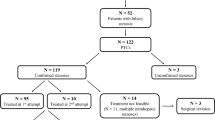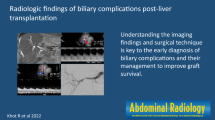Abstract
In pediatric liver transplantation, bile duct complications occur with a greater incidence than vascular anastomotic dysfunction and represent a major source of morbidity and mortality. While surgical re-anastomosis can reduce the need for retransplantation, interventional radiology offers minimally invasive and graft-saving therapies. The combination of small patient size and prevailing Roux-en-Y biliary enteric anastomotic techniques makes endoscopic retrograde cholangiopancreatography difficult if not impossible. Expertise in percutaneous management is therefore imperative. This article describes post-surgical anatomy, pathophysiology and noninvasive imaging of biliary complications. We review percutaneous techniques, focusing heavily on biliary access and interventions for reduced liver grafts. Subsequently we review the results and adverse events of these procedures and describe conditions that masquerade as biliary obstruction.
















Similar content being viewed by others
References
Griffith JF, John PR (1996) Imaging of biliary complications following paediatric liver transplantation. Pediatr Radiol 26:388–394
Laor T, Hoffer FA, Vacanti JP, Jonas MM (1998) MR cholangiography in children after liver transplantation from living related donors. AJR Am J Roentgenol 170:683–687
Norton KI, Lee JS, Kogan D et al (2001) The role of magnetic resonance cholangiography in the management of children and young adults after liver transplantation. Pediatr Transplant 5:410–418
Hsiao CY, Ho CM, Wu YM et al (2019) Biliary complication in pediatric liver transplantation: a single-center 15-year experience. J Gastro Surg 10:1–9
Seda-Neto J, Antunes da Fonseca E, Pugliese R et al (2016) Twenty years of experience in pediatric living donor liver transplantation: focus on hepatic artery reconstruction, complications, and outcomes. Transplantation 100:1066–1072
Kling K, Lau H, Colombani P (2004) Biliary complications of living related pediatric liver transplant patients. Pediatr Transplant 8:178–184
Feier FH, da Fonseca EA, Seda-Neto J, Chapchap P (2015) Biliary complications after pediatric liver transplantation: risk factors, diagnosis and management. World J Hepatol 7:2162–2170
Mitchell JW, Maduabia AI, Cristescu M, Peters GL (2019) Percutaneous management of posttransplant biliary complications. Dig Dis Interv 3:287–294
Akram A, Klapheke R, Kwong W (2019) Endoscopic management of biliary complications after liver transplant. Dig Dis Interv 3:295–304
Berrocal T, Parrón M, Alvarez-Luque A et al (2006) Pediatric liver transplantation: a pictorial essay of early and late complications. Radiographics 26:1187–1209
Vilca-Melendez H, Heaton ND (2004) Paediatric liver transplantation: the surgical view. Postgrad Med J 80:571–576
Tanaka H, Fukuda A, Shigeta T et al (2010) Biliary reconstruction in pediatric live donor liver transplantation: duct-to-duct or Roux-en-Y hepaticojejunostomy. J Pediatr Surg 45:1668–1675
Karakayal F, Kırnap M, Akdur A et al (2013) Biliary complications after pediatric liver transplantation. Transplant Proc 45:3524–3527
Catalano OA, Singh AH, Uppot RN et al (2008) Vascular and biliary variants in the liver: implications for liver surgery. Radiographics 28:359–378
Heffron TG, Emond JC, Whitington PF et al (1992) Biliary complications in pediatric liver transplantation. A comparison of reduced-size and whole grafts. Transplantation 53:391–395
Northover JM, Terblanche J (1979) A new look at the arterial supply of the bile duct in man and its surgical implications. Br J Surg 66:379–384
Zajko AB, Campbell WL, Logsdon GA et al (1987) Cholangiographic findings in hepatic artery occlusion after liver transplantation. AJR Am J Roentgenol 149:485–489
Sanchez-Urdazpal L, Batts KP, Gores GJ et al (1993) Increased bile duct complications in liver transplantation across the ABO barrier. Ann Surg 218:152
Egawa H, Uemoto S, Inomata Y et al (1998) Biliary complications in pediatric living related liver transplantation. Surgery 124:901–910
Egawa H, Inomata Y, Uemoto S et al (2001) Biliary anastomotic complications in 400 living related liver transplantations. World J Surg 25:1300–1307
Pariente D, Riou JY, Schmit P et al (1990) Variability of clinical presentation of hepatic artery thrombosis in pediatric liver transplantation: role of imaging modalities. Pediatr Radiol 20:253–257
Fulcher AS, Turner MA (1999) Orthotopic liver transplantation: evaluation with MR cholangiography. Radiology 211:715–722
Chu WC, Yeung DT, Lee KH et al (2005) Feasibility of morphologic assessment of vascular and biliary anatomy in pediatric liver transplantation: all-in-one protocol with breath-hold magnetic resonance. J Pediatr Surg 40:1605–1611
Kinner S, Schubert TB, Said A et al (2017) Added value of gadoxetic acid-enhanced T1-weighted magnetic resonance cholangiography for the diagnosis of post-transplant biliary complications. Eur Radiol 27:4415–4425
Tamrazi A, Vasanawala SS (2011) Functional hepatobiliary MR imaging in children. Pediatr Radiol 41:1250–1258
Ayyala RS, Anupindi SA, Gee MS et al (2019) Intravenous gadolinium-based hepatocyte-specific contrast agents (HSCAs) for contrast-enhanced liver magnetic resonance imaging in pediatric patients: what the radiologist should know. Pediatr Radiol 49:1256–1268
Treves ST, Gelfand MJ, Fahey FH, Parisi MT (2016) Update of the North American consensus guidelines for pediatric administered radiopharmaceutical activities. J Nucl Med 57:15N–18N
Tulchinsky M, Ciak BW, Delbeke D et al (2010) SNM practice guideline for hepatobiliary scintigraphy 4.0. J Nucl Med Technol 38:210–218
Concannon RC, Howman-Giles R, Shun A, Stormon MO (2009) Hepatobiliary scintigraphy for the assessment of biliary strictures after pediatric liver transplantation. Pediatr Transplant 13:977–983
Kim YJ, Lee KT, Jo YC et al (2011) Hepatobiliary scintigraphy for detecting biliary strictures after living donor liver transplantation. World J Gastroenterol 17:2626
Demetris AJ, Jaffe R, Starzl TE (1987) A review of adult and pediatric post-transplant liver pathology. Pathol Annu 22:347–386
Venkatesan AM, Kundu S, Sacks D et al (2010) Practice guideline for adult antibiotic prophylaxis during vascular and interventional radiology procedures. J Vasc Interv Radiol 21:1611–1630
Kimberlin DW, Brady MT, Jackson MA (eds) (2018) Red book: 2018–2012: report of the Committee on Infectious Diseases. American Academy of Pediatrics, Itasca
Thompson CM, Saad NE, Quazi RR et al (2013) Management of iatrogenic bile duct injuries: role of the interventional radiologist. Radiographics 33:117–134
Harris VJ, Kopecky KK, Harman JT, Crist DW (1993) Percutaneous transhepatic drainage of the nondilated biliary system. J Vasc Interv Radiol 4:591–595
Bret PM, de Stempel JV, Atri M et al (1988) Intrahepatic bile duct and portal vein anatomy revisited. Radiology 169:405–407
Lim JH, Ryu KN, Ko YT, Lee DH (1990) Anatomic relationship of intrahepatic bile ducts to portal veins. J Ultrasound Med 9:137–143
Guimaraes M, Uflacker A, Schonholz C, Uflacker R (2010) Successful recanalization of bile duct occlusion with a radiofrequency puncture wire technique. J Vasc Interv Radiol 21:289–294
Miraglia R, Luca A, Maruzzelli L et al (2007) Percutaneous recanalization of an occluded hepatico-jejunostomy, using Colapinto needle, in a two-yr-old [sic] patient after partial liver transplantation. Pediatr Transplant 11:676–679
Paolantonio G, Pietrobattista A, Parapatt GK et al (2018) Successful percutaneous transhepatic recanalization of a completely obstructed hepatico‐jejunal anastomosis in a child with liver transplantation: unusual employment of the transseptal puncture system. Pediatr Transplant 22:e13293
Shah JN, Haigh WG, Lee SP et al (2003) Biliary casts after orthotopic liver transplantation: clinical factors, treatment, biochemical analysis. Am J Gastroenterol 98:1861–1867
Barton P, Steininger R, Maier A et al (1995) Biliary sludge after liver transplantation: 2. treatment with interventional techniques versus surgery and/or oral chemolysis. AJR Am J Roentgenol 164:865–869
Srinivasa RN, Pampati R, Patel N et al (2018) Interventional radiology-operated endoscopy: indications, implementation, and innovation. Semin Intervent Radiol 35:477–485
Makary MS, Farrell JJ, Khayat M et al (2019) Biliary endoscopy for benign and malignant biliary strictures. Tech Vasc Interv Radiol 22:135–138
Dopazo C, Diez I, Quintero J et al (2018) Role of biodegradable stents as part of treatment of biliary strictures after pediatric and adult liver transplantation: an observational single-center study. J Vasc Interv Radiol 29:899–904
Huespe PE, Oggero S, de Santibañes M et al (2018) Percutaneous patency recovery and biodegradable stent placement in a totally occluded hepaticojejunostomy after paediatric living donor liver transplantation. Cardiovasc Interv Radiol 42:466–470
Siiki A, Sand J, Laukkarinen J (2018) A systematic review of biodegradable biliary stents: promising biocompatibility without stent removal. Eur J Gastroenterol Hepatol 30:813–818
Holguin AJ, Rodriguez-Takeuchi S, Ospina L et al (2017) Biliary strictures complicating liver transplantation in pediatric patients: experience in a South American transplant center. Clin Transplant. https://doi.org/10.1111/ctr.12877
Imamine R, Shibata T, Yabuta M et al (2015) Long-term outcome of percutaneous biliary interventions for biliary anastomotic stricture in pediatric patients after living donor liver transplantation with Roux-en-Y hepaticojejunostomy. J Vasc Interv Radiol 26:1852–1859
Uller W, Wohlgemuth WA, Hammer S et al (2014) Percutaneous treatment of biliary complications in pediatric patients after liver transplantation. Rofo 186:1127–1133
Moreira AM, Carnevale FC, Tannuri U et al (2010) Long-term results of percutaneous bilioenteric anastomotic stricture treatment in liver-transplanted children. Cardiovasc Interv Radiol 33:90–96
Fonio P, Calandri M, Faletti R et al (2015) The role of interventional radiology in the treatment of biliary strictures after paediatric liver transplantation. Radiol Med 120:289–295
Miraglia R, Maruzzelli L, Caruso S et al (2008) Percutaneous management of biliary strictures after pediatric liver transplantation. Cardiovasc Interv Radiol 31:993–998
Sunku B, Salvalaggio PR, Donaldson JS et al (2006) Outcomes and risk factors for failure of radiologic treatment of biliary strictures in pediatric liver transplantation recipients. Liver Transpl 12:821–826
Belenky A, Mor E, Bartal G et al (2004) Transhepatic balloon dilatation of early biliary strictures in pediatric liver transplantation: successful initial and mid-term outcome. Cardiovasc Interv Radiol 27:491–494
Lorenz JM, Funaki B, Leef JA et al (2001) Percutaneous transhepatic cholangiography and biliary drainage in pediatric liver transplant patients. AJR Am J Roentgenol 176:761–765
Sanada Y, Katano T, Hirata Y et al (2019) Long-term outcome of percutaneous transhepatic biliary drainage for biliary strictures following pediatric liver transplantation. Clin Transplant 33:e13570
Lee AY, Lehrman ED, Perito ER et al (2021) Non‐operative management of biliary complications after liver transplantation in pediatric patients: a 30‐year experience. Pediatr Transplant 5:e14028
Anderson CD, Turmelle Y, Darcy M et al (2010) Biliary strictures in pediatric liver transplant recipients — early diagnosis and treatment results in excellent graft outcomes. Pediatr Transplant 14:358–363
Prajapati HJ, Kavali P, Kim HS (2017) Percutaneous interventional management of biliary complications after pediatric liver transplantation: a 16‐year single‐institution experience. Pediatr Transplant 21:e12837
Kirkpatrick DL, Hasham H, Collins Z et al (2018) The utility of a benign biliary stricture protocol in preventing symptomatic recurrence and surgical revision. J Vasc Interv Radiol 29:688–694
Ahlawat SK, Fishbien TM, Haddad NG (2008) Cystic duct remnant mucocele in a liver transplant recipient. Pediatr Radiol 38:884–886
Chatterjee S, Das D, Hudson M et al (2011) Mucocele of the cystic duct remnant after orthotopic liver transplant: a problem revisited. Exp Clin Transplant 9:214–216
Colina F, García-Prats MD, Moreno E et al (1994) Amputation neuroma of the hepatic hilum after orthotopic liver transplantation. Histopathology 25:151–157
Quillin III RC, Bongu A, Kasper V et al (2018) Roux‐en‐Y enterolith leading to obstruction and ischemic necrosis after pediatric orthotopic liver transplantation. Pediatr Transplant 22:e13160
Schemmer P, Schultze DP, Contin P et al (2011) Antireflux jejunoplasty for recurrent cholangitis. J Am Coll Surg 212:e28-32
Vrochides D, Fischer SA, Soares G, Morrissey PE (2007) Successful treatment of recurrent cholangitis complicating liver transplantation by Roux-en-Y limb lengthening. Transplant Infect Dis 9:327–331
Marangoni G, Ali A, Faraj W et al (2011) Clinical features and treatment of sump syndrome following hepaticojejunostomy. Hepatobiliary Pancreat Dis Int 10:261–264
Author information
Authors and Affiliations
Corresponding author
Ethics declarations
Conflicts of interest
Eric J. Monroe is a scientific adviser and speaker for Biogen. Jeffrey Forris Beecham Chick is a consultant and speaker for Inari Medical, Guerbet, C.R. Bard, Argon Medical Devices and Boston Scientific. Kevin S.H. Koo is a consultant for Medtronic.
Additional information
Publisher's note
Springer Nature remains neutral with regard to jurisdictional claims in published maps and institutional affiliations.
Supplementary Information
Below is the link to the electronic supplementary material.
Supplementary file1 (AVI 1761 KB)
Rights and permissions
About this article
Cite this article
Monroe, E.J., Shin, D.S., Young, V.A. et al. Evaluation and management of biliary complications after pediatric liver transplantation: pearls and pitfalls for percutaneous techniques. Pediatr Radiol 52, 570–586 (2022). https://doi.org/10.1007/s00247-021-05212-7
Received:
Revised:
Accepted:
Published:
Issue Date:
DOI: https://doi.org/10.1007/s00247-021-05212-7




